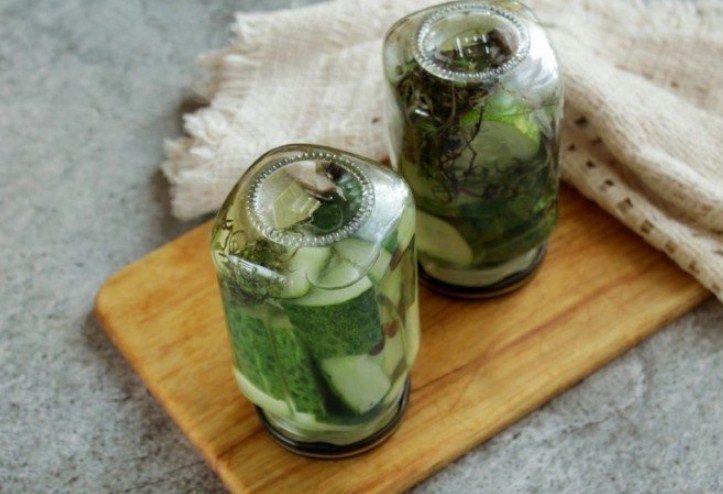In the summer months of the kitchen of many housewives, in fact, they turn into mini-conservation factories, in which everything is soared, cooked, boiled, sterilized. Bars in even rows are built on the shelves of cellars and basements, and in winter they delight with their contents, but how to ensure that not one of them “explodes”, but to stand before it is open?
Contents
- Why do banks turn over with jam, conservation after a twist?
- Do I need to turn jars with twisting, screw lids?
- Do I need to turn jars with plastic lids?
- Do I need to turn cans with compote and juice?
- Do I need to turn jars with jam after spin?
- What to do if the bank leaks after turning?
- How to turn the jar to turn after a spin?
- Why cover inverted banks during conservation?
- How much should the banks stand upside down after rolling up?
- Whether the hostesses turn over: reviews
- Video: How to roll banks for perfect conservation?
One way is to turn the cans after they were rolled up. This is how our grandmothers did, our mothers do this and we do the same. But why do this and is it necessary to turn cans with conservation after a spin at all? We will talk about this.
Why do banks turn over with jam, conservation after a twist?
- The taste of the contents of the can and most importantly - safety, like the shelf life, depends on how hermetically the bank is sealed. It is turning the jar with a lid that makes it possible to make sure that seed, juice or compote does not follow it.
- After all, if the lid is rolling not quite tightly and even the slightest access to the contents receives the air, it can eventually bubbles appear and bloating. And if you notice a similar phenomenon in any of the cans-it should be immediately open and throw out the contents, Since it is already spoiled and can cause harm to health.
- In addition, while the bank stands inverted, its cover and neck are additionally sterilized with just boiled brine, compote or juice, which increases the reliability of storage of conservation.

- In culinary textbooks, a similar process is called self -awards. And if you did everything right during the preparation of pickles, then the marinade in banks will remain transparent, and if you make a mistake somewhere, it will become cloudy, and the lid can swell.
- And another aspect - the filled bank, when turned over, presses on the lid, preventing the fact that during the cooling process there will be a skew or a delay of rubber in the lid.
Do I need to turn jars with twisting, screw lids?
- Today, screw and twisting lids are especially popular because they fit tightly to the bank, thereby ensuring the tightness of the twist. And the ability to use, in particular, screws repeatedly also is of great importance.
- But no matter how tightly, in our opinion, the cap is adjacent, the process remains unchanged. The sterilized cover is tightly rolled or screwed, after which the hot bank turns upside down.
- If in a few hours no leakage appears on the surface under the lid, it means that the bank is twisted tightly and hermetically And he will be able to be stored for a long time.

Do I need to turn jars with plastic lids?
- Plastic covers are not intended for long storage of jams or pickles. They are used, as a rule, after the tin cover on the conservation has been open, and jam or saturation remained in the bank. It was then, before sending the jar in the refrigerator, and a plastic cover will come in handy.
- There are also several methods of salting in which plastic covers are used: as a rule, cold water is used for marinade in such cases. Such banks do not turn after putting the covers on them, since the shelf life of such conservation is less than that of the usual one, and most often such banks are immediately put in the refrigerator.
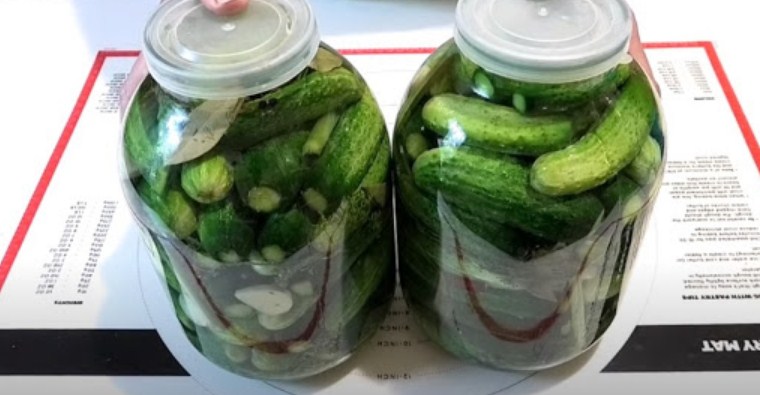
Do I need to turn cans with compote and juice?
- It is necessary to turn jars with compote. It is when closing compote and juice to the winter easier and fastest to make sure that the bank is completely tightly sealed.
- The liquid contained inside will immediately begin to appear under the lid or on its rim if the tightness is disturbed.
- Problems can manifest itself in the form subtecs, gradually accumulating puddles or bubbles that will appear on the rim of the lid itself. If nothing of the kind is 10-15 minutes. It does not happen - it means that everything is in order, and the bank is closed tightly and reliably.
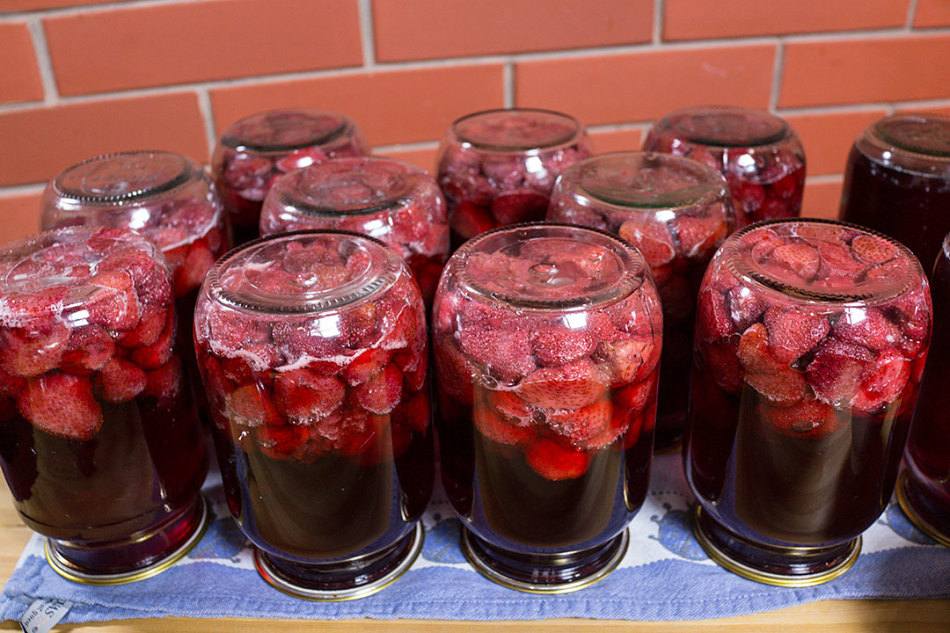
Do I need to turn jars with jam after spin?
- Using a large amount of sugar when cooking jam allows the product stay without additional sterilization, which is ensured by turning. That is why jam, especially if the classic recipe was used, You can not turn over after rolling.
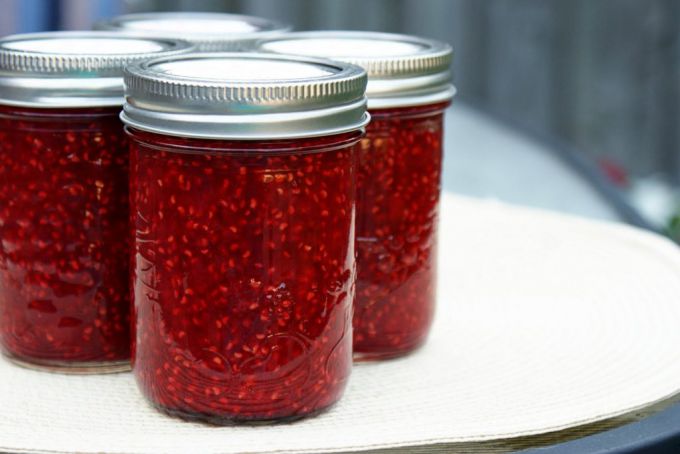
- In this case, the tightness of tightness will also not work, since jam usually has viscous and thick consistency and does not produce from under the lid.
- In addition, classic culinary recipes are advised to roll the jam with lids in general after it cools down - this is how you can avoid the appearance of mold on top of sweets during storage.
- In this case, it should be taken into account, turning jars with jam should turn over if it is welded without sugar or with a small amount. With such a recipe, there is no main preservative - sugar, and additionally sterilize both the jar and the cover by turning the container will be very useful.
What to do if the bank leaks after turning?
- It may happen that a liquid appears under the cover of an inverted can. This means that in some place the tightness is broken, Therefore, sneakers occur.
- In this case, you need Open the jar and re -reduce the liquid in it, including jam.
- If there are cucumbers, tomatoes or other whole vegetables in the bank - sprinkle the brine.
- Having done this procedure, you will avoid damage to the contents of the jar, bloating or tearing the lid during subsequent storage.
How to turn the jar to turn after a spin?
- You need to do this, observing all the precautions: take a hot jar from the sides with only a towel or special kitchen tacks, and in no case with bare hands, so as not to burn.
- All movements should be leisurely and smooth so as not to create a sharp tension on the neck of the jar, which can simply burst.
- Before putting a can on a table or other surface, you must make sure that it is completely flat.
- And do not knock on the bottom of the jar after you put it upside down.
Why cover inverted banks during conservation?
- Covering upside down cans with conservation blanket, plaid, terry towelWe thereby create favorable conditions for the high temperature inside the cans are maintained as long as possible.
- Thus, the contents of the can pass The stage of additional sterilization, which helps better preservation of conservation. In addition, the product itself turns out to be more tasty due to the fact that additionally languishes in the marinade, impregnated with him and acquiring the saturation and piquancy of taste. Yes, and spices that housewives, as a rule, put not only the bottom of the banks, but also on top of the main products, additionally suffer and release the aromas of essential oils.
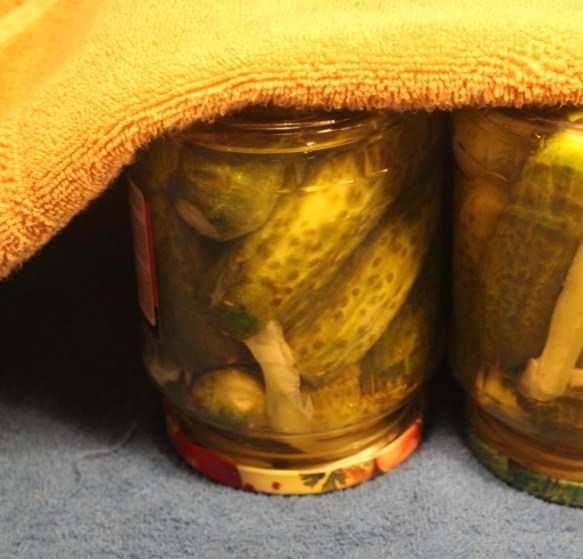
- And one moment, the slower the bank cools, the greater the likelihood of the integrity of the glassfrom which it is made. Sudden temperatures are harmful to the glass, so if hot, just flushed with boiling marinade or juice of the bank, immediately contacts the cold surface, it can crack.
- Sometimes inverted banks are not covered, but installed in a bathroom with hot water or in a pan, where they passed the sterilization process. In this case, cold water is gradually added to hot water, thereby reducing the temperature in banks. When it reaches 35-40 ° C, banks can continue to cool just in the air.
How much should the banks stand upside down after rolling up?
- As a rule, banks turn over when canned and withstand them under the blanket until the moment of cooling. It is important that they do not stand in a draft, which contributes to faster cooling.
Typically, small jars are enough for cooling for 15-25 minutes, half a liter-up to half an hour, liter banks will take up to 3 hours, and two- and three-liter-at least 6 hours. If you canned in the evening, you can safely leave the banks turned upside down all night.
- After cooling, the banks are transferred to the place of storage. At first, it is better to periodically check all the conservation - whether the bubbles appear in the banks, whether the brine is clouding and whether the lids are swollen.
Whether the hostesses turn over: reviews
- Natalia, 30 years: When I canned, I always turn the banks after rushing. I don’t even know why this is being done, but this is how my grandmother did, and then my mother. The main thing is that conservation is stored for a long time and successfully, without exploding.
- Svetlana, 44 years old: At first I turned the banks, as my mother did, but recently I stopped doing it. I just sterilize both cans and lids well. And everything seems to be fine, not a single bank exploded.
- Irina, 23 years old: I mainly close the jam, since we are all in the family are sweet. I do not turn the banks - I wait until the jam has cooled in them and a solid crust appears on top. Here I cover it with a passed paper leaflet and then close the jar with a sterilized dry lid. I turn only over the fifth jam, since it is liquid, and it is smaller than sugar in it.
- Olga, 52 years old: I always turn over any twists: jam, and pickles, and drinks. I got used to doing this and have been going on for many years now. I believe that this is a tradition that should not be violated, because the conservation is stored well, although it stands in the apartment, and not in the cellar.
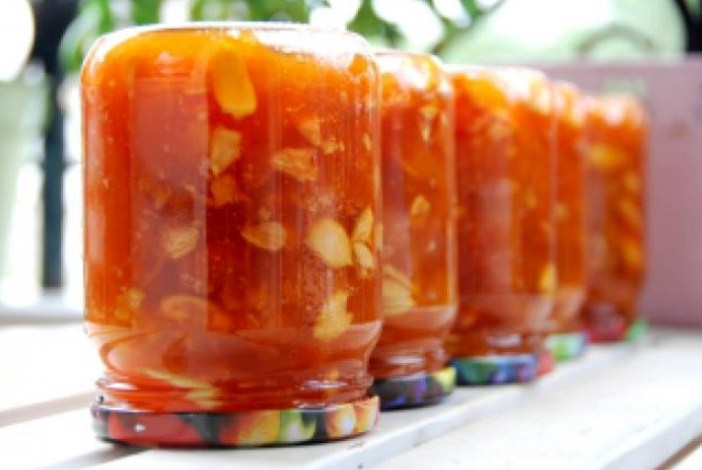
Advice:If you find that the marinade in an inverted jar is clouding, bubbles appear or the lid begins to swell, then immediately cross the contents and close again, observing all the rules.
We will also tell you why and why:
- Hung red underpants on a chandelier
- The temperature has been held for a long time
- A rapid pulse occurs
- There is blood in raw chicken eggs

